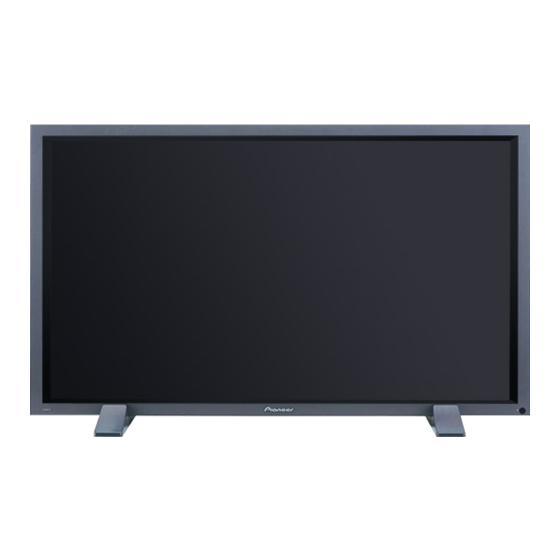Pioneer PDP-503MXE Технічний посібник - Сторінка 3
Переглянути онлайн або завантажити pdf Технічний посібник для Монітор Pioneer PDP-503MXE. Pioneer PDP-503MXE 25 сторінок. Plasma display monitor

5.4 Integrator Mode ......................................................... 128
5.4.1 About the integrator mode .............................. 128
5.4.2 Example of integrator mode operation ............ 129
5.4.3 Adjustments and settings in integrator mode ... 131
1) Adjusting PICTURE (picture quality) .......... 131
2) Adjusting WHITE BALANCE ..................... 132
3) Adjusting SCREEN (screen position) ......... 133
4) Setting the 4-screen display (2x2 mode) ... 134
5) Setting brightness enhancement
at screen center ........................................ 135
6) Setting the HDTV MODE .......................... 136
7) Setting component input ........................... 137
8) Adjusting SUB VOLUME ........................... 138
9) Setting the OSD display ............................ 140
10) Setting the baud rate ................................. 141
11) Setting OFF TIMER ................................... 142
12) Setting FULL MASK .................................. 143
13) Adjusting SIDE MASK ............................... 144
14) Setting MASK CONTROL .......................... 145
15) Setting ORBITER MODE ........................... 146
16) Setting INVERSE MODE
(negative-positive inversion) ...................... 147
17) Setting COLOR MODE ............................. 148
18) Setting MIRROR MODE ........................... 149
19) Setting the cooling fan control formula ..... 150
20) Assigning a name to the monitor .............. 151
21) Assigning an ID ......................................... 152
22) Input settings when using a video card
other than the PDA-5002 .......................... 153
23) Simple checking of internal temperature .. 154
24) Checking the accumulated ON time ......... 155
5.4.4 PICTURE and WHITE BALANCE adjustment
values memory area tables .............................. 156
5.4.5 SCREEN adjustment values area tables .......... 158
5.5 RS-232C Adjustment Mode ....................................... 160
5.5.1 About the RS-232C adjustment mode ............. 160
5.5.2 Interface .......................................................... 161
5.5.3 ID assignment ................................................. 163
5.5.4 List of RS-232C commands ............................. 164
5.5.5 GET commands ............................................... 167
5.6 Combination Connection ........................................... 170
5.7 KEY LOCK/UNLOCK .................................................. 172
5.7.1 Functions ......................................................... 172
5.7.2 How to switch KEY LOCK/UNLOCK ................ 172
5.8 Regarding the problem of images becoming
burnt onto the screen ................................................ 173
5.9 Cautions on connecting camera images .................... 174
OPERATING PRECAUTIONS AND RECOMMENDATIONS
6.1 Operating Precautions and recommendations .......... 175
MAINTENANCE AND CLEANING ..................................... 176
CAUTION
• To prevent injury and material damage, thoroughly read
this manual and all labels found on the equipment before
attempting to mount, install, move, or adjust the product.
• Do not install the unit outside or in the open air. Doing
so will lead to water seepage into the system, resulting
in fire or electric shock.
• Be especially careful when working around parts of the
system that have sharp edges.
• When performing installation work from a height, take
suitable precautions to guard against falling. Set up a
barrier around the work site to prevent accidentally
dropped objects from injuring persons standing or
walking below.
• Keep all foreign objects out of the unit. Do not tamper
with the unit, or fire or electric shock may result.
• Observe the following operating environmental
limitations:
Temperature: 0 to 40°C
Humidity: 20 to 80%
• Install the unit only in properly ventilated areas.
Table of Contents
3
